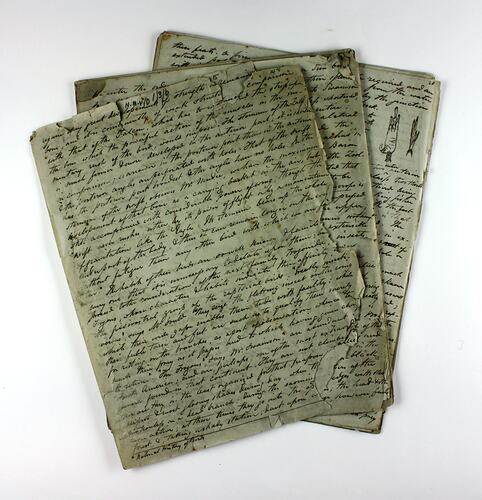Summary
Archive of writings by and about ornithologist John Cotton. Cotton arrived in Victoria from England with his family in 1843, already a published ornithologist. He went on to document a large number of Victorian bird species, intending to publish his work as a book. He passed away in 1849, before his work was completed.
The archive includes his diary, manuscripts and sketches, as well as transcriptions and later research notes. John Cotton's writings are likely to have come to Museum Victoria in the early 1970s during research by Allan McEvey, then Curator of Birds at Museum Victoria.
John Cotton was born in London in 1801. He studied law at Oxford University before going to work for a legal firm. But his interests lay elsewhere: he was passionate about birds. By the age of 33 he had published The Resident Song Birds of Great Britain. In 1843 Cotton sailed for Port Phillip with his wife Susannah, their four sons, five daughters and several female servants. He documented the voyage in the book of poems Journal of a Voyage in the Barque 'Parkfield' . in the Year 1843 (London, 1845) - one of the first pieces of Australian verse published.
Cotton and his family landed in Melbourne. Before long they were on the move again, travelling to the Goulburn River valley where Cotton leased the first of several stations, 'Doogallook'. By 1846 he held more than 155 km² and expected to run 10,000 sheep. Yet it was birds which remained his passion, and he keenly observed his new environment. In 1848 he published a list of Victorian birds in the Tasmanian Journal of Natural Science, and he was made a fellow of the Royal Zoological Society in London.
Cotton began work on a book on the birds of Victoria illustrated with coloured plates from his own drawings. Tragically, he would never see the book published. He died on 15 December 1849, aged 47, leaving his wife and 10 children. Susannah died only three years later. His book was finally published in 1974 as John Cotton's Birds of the Port Phillip District of New South Wales 1843-1849 (ed. Allan McEvey). His coloured plates are today largely held by the State Library of Victoria.
Physical Description
Approximately 100 pages in manila folders and plastic sleeves, housed in a single box. Mainly comprising a range of yellowed letters and manuscripts written by John Cotton, it also includes several folders of researchers' notes, undated and largely unauthored.
Significance
At the time John Cotton drew the taxonomy included in the archive, a taxonomic order for birds was not widely agreed by the scientific community. James Rennie had just published his Natural History of Birds: Their Architecture, Habits, and Faculties (1839), articulating the quinary system of classification for birds that was popular in England; and George Robert Gray, Assistant-Keeper of Birds at the British Museum, was working on his Genera of Birds (1844-49), based on the Cuvierian classification with its rostral system, used in France from around 1800. Charles Darwin had laid the groundwork for a taxonomy based on descent in 1859; and in 1867 Thomas Huxley constructed his celebrated ' Classification of Birds', based on Darwinian principles.
Cotton himself used the quinary system of classification. The modifications made to his diagram are a significant record of his attempt to work through the taxonomy and contribute to taxonomic thinking.
The history of the actual archive is unclear, but it appears to have been passed down through his descendants. A review by Roy Wheeler of John Cotton's Birds of the Port Phillip District of New South Wales 1843-1849 in the journal Emu (76 (1): 46) casts light on the arrival of the archive at Museum Victoria:
'Cotton's information would never have been published were it not for the patience and dedication of his great-granddaughter, Maie Casey, wife of one of the great sons of this country, Lord Casey. She contacted relatives from all parts of the world and brought together the greater part of John Cotton's sketch-books, paintings and writings. These she then handed to Allan McEvey former President of the RAOU and Curator of Birds at the National Museum of Victoria in Melbourne. Again with great dedication, he carefully examined and annotated the collection and from it has now produced this book. Including a catalogue of all the drawings in the possession of Lady Casey and fine reproductions at original size of a selection, this represents a most valuable contribution not only to Victorian ornithology but to Australian ornithology as well.' Quoted in Wikipedia, 'John Cotton's Birds of the Port Phillip District of New South Wales 1843-1849', accessed 22/2/2012.
Note that two volumes of Cotton's illustrations of birds are now held at the State Library of Victoria, together with other drawings and writings; his descendants still retain some of his works.
More Information
-
Collecting Areas
Migration & Cultural Diversity, Home & Community, Science & Measurement
-
Acquisition Information
Transfer from Museum Victoria Archives, Feb 2012
-
Author
-
Date Used
Melbourne, Victoria, Australia, 1970-1990
Approximate dates of research notes -
Ship Named
-
Classification
-
Category
-
Discipline
-
Type of item
-
References
Allan McEvey (ed), John Cotton's Birds of the Port Phillip District of New South Wales 1843-1849, published by William Collins (Australia), 1974
-
Keywords
Birds, Scientific Research, Indigenous Cultures, Sciences, Correspondence

